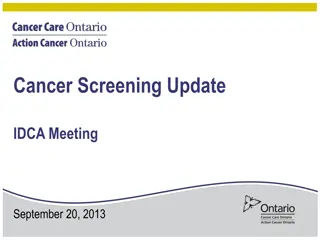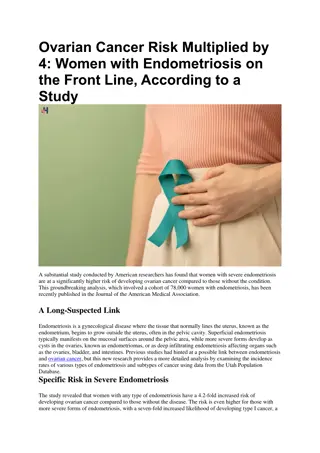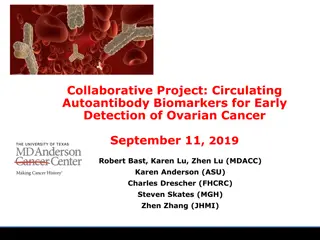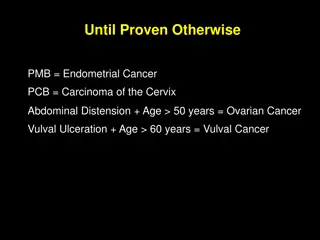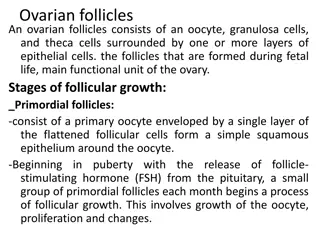Longitudinal Biomarker Interpretation for Early Detection of Ovarian Cancer
This presentation explores the use of longitudinal CA125 as a biomarker for early detection of ovarian cancer, discussing screening trials, cancer death rates, advances in therapy, and the importance of early detection in improving survival rates.
Download Presentation

Please find below an Image/Link to download the presentation.
The content on the website is provided AS IS for your information and personal use only. It may not be sold, licensed, or shared on other websites without obtaining consent from the author.If you encounter any issues during the download, it is possible that the publisher has removed the file from their server.
You are allowed to download the files provided on this website for personal or commercial use, subject to the condition that they are used lawfully. All files are the property of their respective owners.
The content on the website is provided AS IS for your information and personal use only. It may not be sold, licensed, or shared on other websites without obtaining consent from the author.
E N D
Presentation Transcript
Longitudinal Biomarker Interpretation for Early Detection of Ovarian Cancer EDRN SC Meeting Seattle 12-14 September 2017 Steven J. Skates PhD Massachusetts General Hospital and Harvard Medical School
Acknowledgements and Declaration of Interests Ian Jacobs Usha Menon Robert Bast Karen Lu Robert Knapp Michael Birrer Dianne Finkelstein Mark Greene Funding: MRC, CR-UK, Eve Appeal, NCI EDRN Co-developer of ROC algorithm with Ian Jacobs (1996) MGH & QMUL (2014) licensed software to Abcodia Consultant to Abcodia
Outline CA125 First trials for early detection of ovarian cancer Risk of Ovarian Cancer given longitudinal CA125 Ovarian Cancer Screening Trials with ROCA Longitudinal Test Results Conclusions
Cancer Death Rates: (US 1930-2006)* Cisplatin Cytoreduction Paclitaxel Cisplatin IP *Age-adjusted to the 2000 US standard population. Source: US Mortality Data 1960-2006, US Mortality Volumes 1930-1959, National Center for Health Statistics, Centers for Disease Control and Prevention, 2009 (American Cancer Society, Cancer Facts & Figures 2010, Atlanta: American Cancer Society, 2010)
Ovarian Cancer Death Rates - Yellow Advances in therapy over 50 years Increased survival (2 -> 4 years) Decreased toxicity Have NOT changed mortality Cisplatin Cytoreduction Paclitaxel Can early detection DECREASE mortality? Cisplatin IP
Ovarian Cancer Early Detection Target? Late stage detection: > 75% Late stage 5 year survival rate: < 20% Early stage 5 year survival rate: >85% Annual Incidence in postmenopausal women: 40-50 per 100,000 (1 in 2,300)
Early Detection with Serum Markers PPV constraint 10% Low incidence and moderate specificity may result in unacceptably low positive predictive value Ovarian Cancer Incidence: 1 in 2,000 women/year CA125 Specificity (> 30U/ml) CA125 Sensitivity Positive Predictive Value : 98% : 63% : 2%
Early Detection with Serum Markers PPV constraint 10% Low incidence and moderate specificity may result in unacceptably low positive predictive value Ovarian Cancer Incidence: 1 in 2,000 women/year CA125 Specificity (> 30U/ml) CA125 Sensitivity Positive Predictive Value : 98% : 63% : 2% Follow-up imaging with TVS : 20%
Ovarian Cancer Screening Previous Studies Screening for familial ovarian cancer: poor survival of BRCA1/2 related cancers. J Med Genet. 2009;46:593-7. Annual surveillance by CA125 and transvaginal ultrasound for ovarian cancer in both high-risk and population risk women is ineffective. BJOG. 2007;114:1500-9. Prospectively detected cancer in familial breast/ovarian cancer screening. Acta Obstet Gynecol Scand. 1999;78:906-11. CA125 and transvaginal ultrasound monitoring in high-risk women cannot prevent the diagnosis of advanced ovarian cancer. Gynecol Oncol. 2006;100:20-6. Biology of epithelial ovarian cancer: implications for screening women at high genetic risk. J Clin Oncol. 2004;22:1315-27. [NO ] Effect of Screening on Ovarian Cancer Mortality: The Prostate, Lung, Colorectal and Ovarian (PLCO) Cancer Screening Randomized Controlled Trial JAMA 2011; 305(22):2295-2303.
CA125 in 3 women with occult ovarian cancer & 3 women without ovarian cancer 1 3 500 2 CA125-II 50 4 6 5 5 88 89 90 91 92 93 94 Year
Expected CA125 Levels in Woman with Ovarian Cancer Prior to Clinical Detection Logarithmic CA125 Scale 1500 1500 Clinical Detection Clinical Detection 500 1000 CA125 CA125 100 Linear Rise 50 Doubling Time 500 Flat Profile 10 * Tumor Inception Tumor Inception 5 Flat Profile 0 * 0 1 2 3 4 0 1 2 3 4 Time in Years Time in Years Rise most readily detected when a baseline has been established
Between Women Sources of CA125 Variability Within Woman Sources of CA125 Variability 50 40 Between Woman Flat Profile Variability 30 CA125 CA125 Linear Rise Within Woman CA125 Variability 20 Flat Profile * Between Woman Slope Variability 15 * Tumor Present 10 2x 0 1 2 Time in Years Time in Years Three Women with Two Serial CA125 Levels All Women have Same Slope yet have Decreasing Levels of the Risk of Ovarian Cancer Within Woman Sources of CA125 Variability 50 40 1 30 Tumor Absent CA125 CA125 2 20 * 15 3 Within Woman CA125 Variability 10 Time in Years Time in Years
Probability or Risk of having Ovarian Cancer The probability of having ovarian cancer given a CA125 profile accounts systematically for all sources of signal and noise The initial baseline level The variability of the baseline level between women The slope over time following the change-point The variability of the slope between women The amount of rise above the baseline level Assay and biological variability over time within a woman
Probability or Risk of having Ovarian Cancer To calculate the probability of having ovarian cancer given a CA125 profile: Develop longitudinal CA125 model for non-cases Transform CA125 (log) Individual constant mean (baseline) Individual variation about baseline Yij = log(CA125), ith patient, time tj Yij = i + ij ij~ N(0, i2) i~ N( , 2) 2 . between woman SD = twice within woman SD
Probability or Risk of having Ovarian Cancer To calculate the probability of having ovarian cancer given a CA125 profile: Develop longitudinal CA125 model for cases Baseline, change-point, linear increase in CA125 (fraction p) Baseline (small proportion not producing CA125: 1-p) Yij = i + i(tij i)+ + ij ij~ N(0, i2) i~ N( , 2); log( i) ~ N( , 2); i ~ N(2, 0.752) T(0,5) i = di i preclinical duration ( i, log( i), i) ~ MVN
Probability of Having Ovarian Cancer 25 Red Dots: CA125 Values Green Line: Flat Pattern Yellow Line: Elbow Pattern 20 z* 5 15 CA125 z* 4 z* * * z3 1 10 Initial odds: From woman s age 8 z* 2 5 Z-values: Distance from Pattern to CA125 values. Smaller distance implies pattern is more likely. 0 3 6 9 12 Time in Months Final Distance: Sum of squared Z values Divided by CA125 variability * 25 z5 20 z4 15 * CA125 * z3 z1 10 Odds: Ratio of average yellow to average green distance 8 * z2 5 Final odds: (Initial odds) * (odds ratio) 0 3 6 9 12 Probability: Odds/(Odds+1) Time in Months
ROCA: Risk of Ovarian Cancer Algorithm Regular CA125 Test Risk of Ovarian Cancer Calculation based on longitudinal CA125 values (ROCC) & age Intermediate Elevated Normal low < ROCC < high ROCC > high ROCC < low Repeat CA125 Interval determined by ROCC TVS + CA125
ROCA Screening Trials 1. UK Pilot Trial (Barts III) 14,000 normal risk women randomized to screen/ no screen 1995 2001 2. ROCA study 2001 2015 2,400 high risk women, age > 30, CGN/SPORE/EDRN 3. UKCTOCS 2001 - 2015 200,000 normal risk, postmenopausal women randomized to screen/ no screen 4. MDACC study in normal 2001-2011 4,000 normal risk postmenopausal women 5. GOG0199 - screening arm 2003-2011 1,600 high risk women, age > 30 UKFOCSS 2003 2013 4,000 high risk women, age > 35 1. 2. 3. 4. 5. 6. 7. Jacobs, The Lancet 1988 Skates, JASA 2001 Menon, JCO 2005 Lu, Cancer 2011 Jacobs Menon, The Lancet 2015 Skates, Clinical Cancer Research 2017 Rosenthal, JCO 2017 6.
ROCA Screening Trials Results All 6 trials significantly increased early stage cancer No other ovarian cancer screening trials had an increase All other ovarian cancer screening trials: single CA125 cutoff Individualizing test with ROCA contributed to early stage increase UKCTOCS had a non-significant Cox regression result for mortality for all cases UKCTOCS had a pre-specified subgroup analysis for incident cases (80% of cases): a significant mortality reduction
Conclusions Longitudinal test relies on each patient having their own baseline levels of a test (sigma-within << sigma-between) Longitudinal interpretation of test for each patient led to significant increase in detection of early stage disease Longitudinal test most effective when baseline has been measured (incident cases) Longitudinal test reduced mortality for incident cases Longitudinal method applied to existing or novel biomarkers may substantially increase impact







